Meet the BMW CE 04, a distinctive, practical electric scoot that’s totally addictive to ride, and heaps of fun
Electric two-wheelers have been the coming thing for the past decade, but love them or hate them – and there are plenty of people on both sides of that particular fence – they’re set to become an ever-increasing fact of life in coming years. Almost inevitably it’s BMW Motorrad which has recently introduced a volume production E-model, with the debut of its 2022 CE 04 midsize scooter.
It’s being built alongside the company’s internal combustion engine (ICE) models at its Spandau factory in Berlin, in a special 800m² annexe in which assembly line workers are specially trained in the skills required to assemble such a high-voltage vehicle.
It’s now on sale in 38 countries worldwide, and here in Australia at a ride-away price of $21,915, which is more than double the firm’s own conventional $10,296 C 400 X scooter.

I say inevitably because in 2021 BMW’s passenger car division sold 328,316 electric vehicles, a 70.4 per cent increase over 2020, which represents 13 per cent of its overall production, with EVs accounting for over 23 per cent of sales in Europe. Those figures do not include the C-Evolution E-scooter that BMW had been building since 2014 as a pilot project, 8000 examples of which found customers before production was terminated in 2020, and its Spandau assembly line turned over to the CE 04.
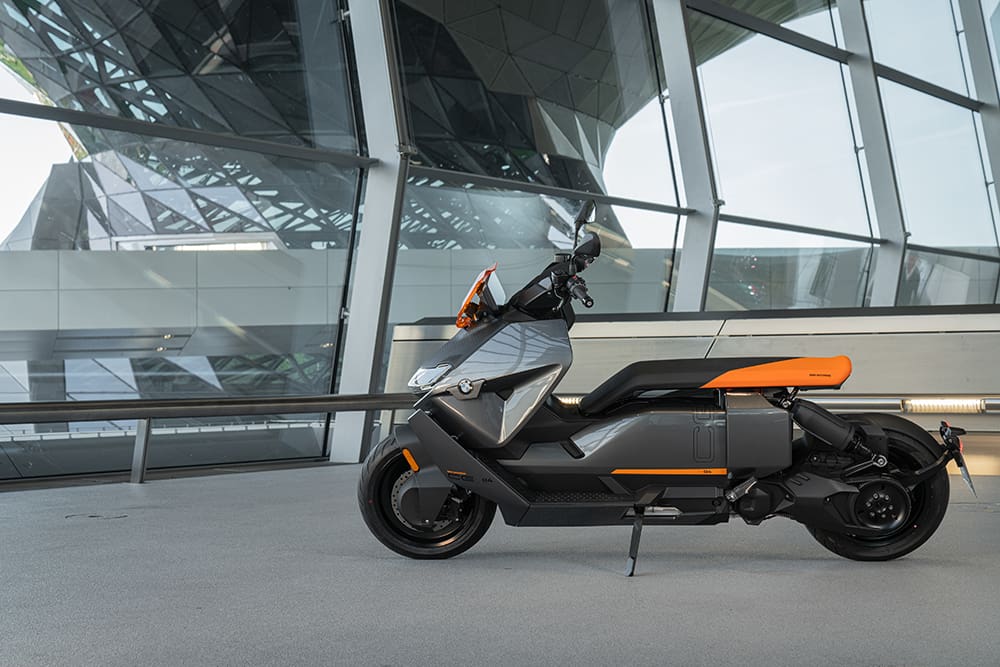
So BMW is at the leading edge of electromobility, and according to its CEO Dr. Markus Schramm, will no longer produce any new combustion engined models for its Urban Mobility segment catering for scooters and city bikes. And from now on, we can expect to see a new electric two-wheeler launched by the German manufacturer every 18 to 24 months, and from 2025 onwards BMW will begin converting some of its motorcycle model segments to electric power, even if at this stage Schramm rules out a total switchover.
“We will not stop making ICE models, but we will extend our electric range beyond the Urban Mobility sector,” he says.

So the CE 04 is the first proper roll of the dice for BMW in the electric evolution, and a pretty impressive looking package compared to the conventional midsize and maxi-scooters it’ll be fighting against for the customer buck. Incidentally, decoding its reference number, there’s a ‘C’ for the firm’s scooter segment, ‘E’ for obvious reasons and ‘04’ refers to the 400cc category it’s positioned in, with Schramm heavily hinting at there being a CE 02 and/or a CE 06 to follow. Makes sense, especially since two months ago BMW penned a joint venture agreement with its Indian partner TVS, builder of its G 310 range of entry-level singles, to expand their long-term partnership dating back to 2013 to jointly develop a new common E-platform, with the first products (plural) from that JV stated as coming in the next two years, with dedicated versions for both brands.
“In light of our fruitful association with TVS, we are delighted to extend our cooperation to include joint development of new platforms, including electric vehicles,” said Schramm.
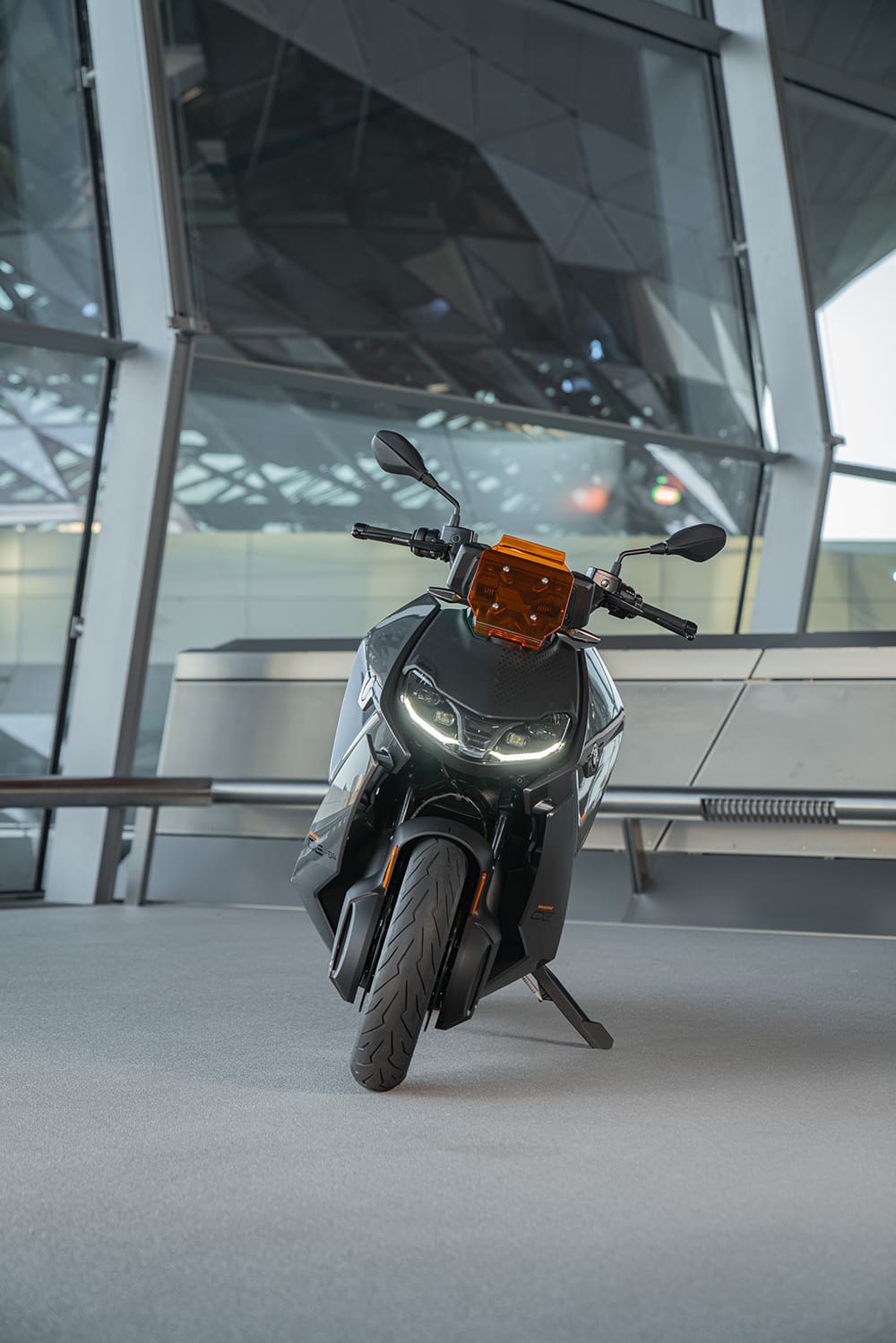
Just as eight years ago with the production C-Evolution, the chance to ride the CE 04 came in Barcelona, an appropriate venue for the global press launch, since this is Europe’s capital of two-wheeled transportation, no matter what they may think in Paris or Rome.
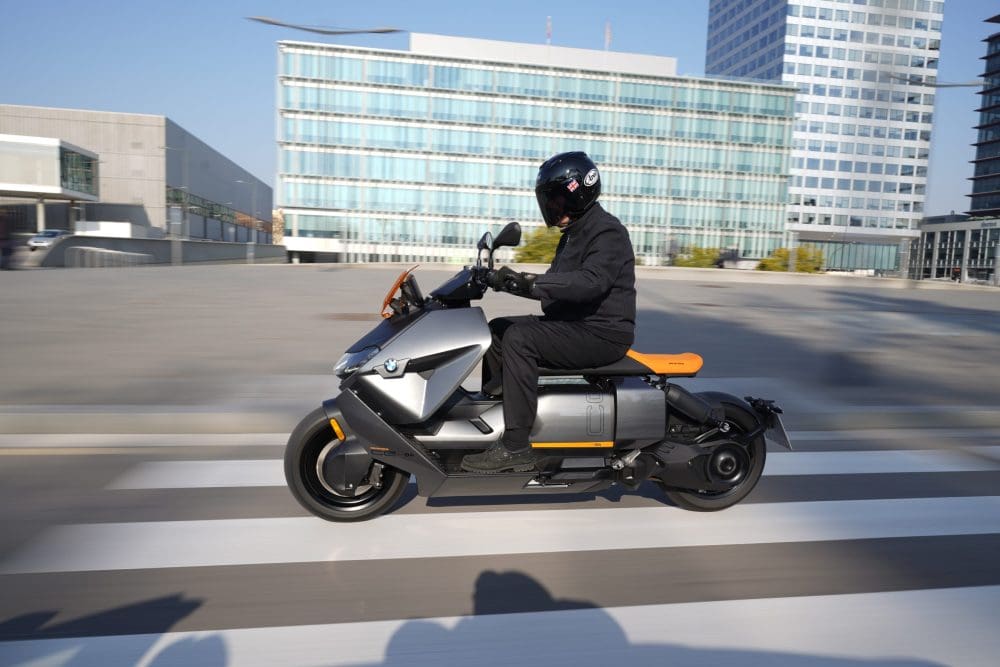
The distinctive looks of the CE 04 denote the fact it was developed back to front by BMW’s normal standards, with its design team headed by Edgar Heinrich (see below) first penning the completely innovative clean-sheet design around certain key elements, before the Engineering mob turned it into reality. The key element in the architecture is the flat 8.90kWh (60.60 Ah) main battery pack, which according to project manager Florian Roemhild, employs one-eleventh of the total modules used in BMW’s iX electric car, and is positioned right at the bottom of the one-piece tubular steel chassis, beneath the footboards.
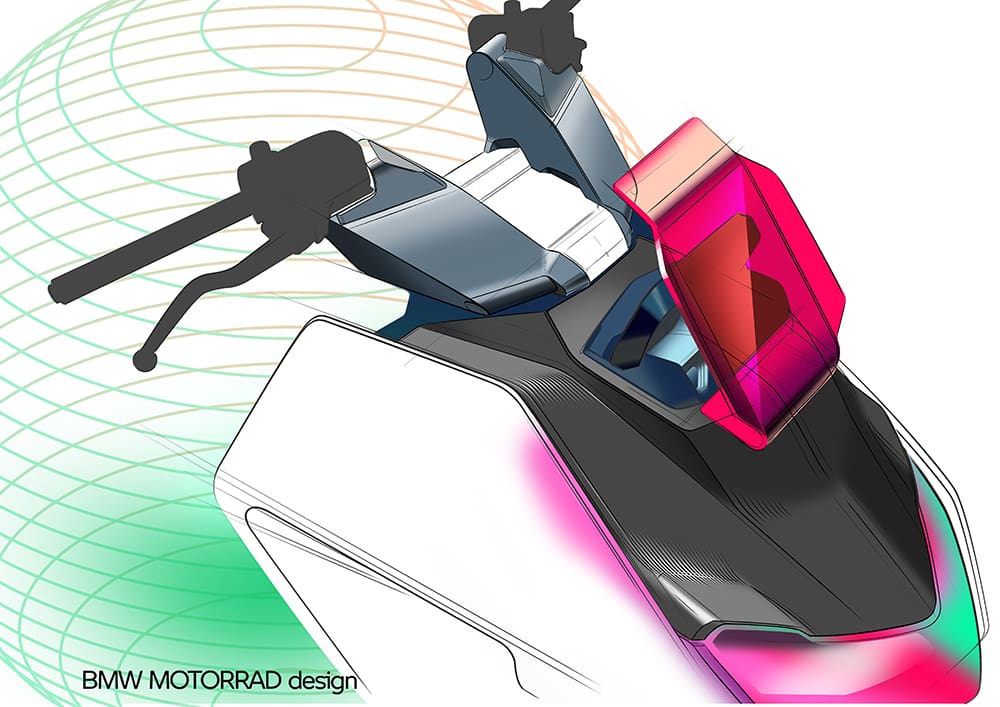
This allows it to be air-cooled via a plate on the underside of the vehicle with longitudinally arranged cooling fins, whereas the permanent magnet synchronous electric motor with surface magnets is conversely liquid-cooled, with a small radiator. The motor is mounted in the frame between the battery and the rear wheel, thus reducing unsprung weight compared to the swingarm-mounted engines in conventional scooters, which enhances rear suspension compliance. There’s a second, 12V battery on board to power items like the dash and all-LED lighting system.
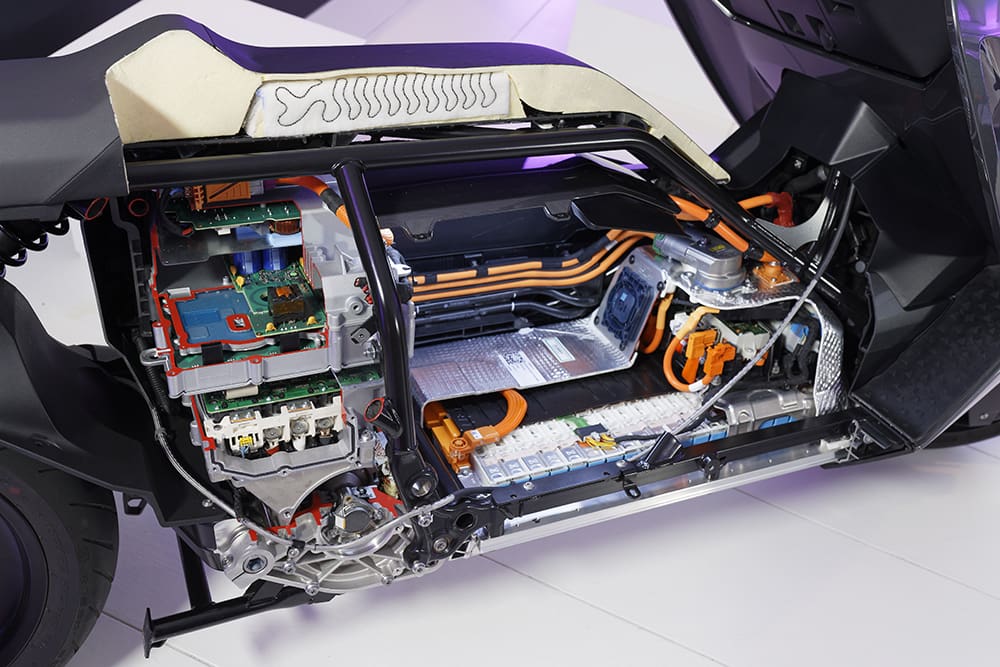
The main battery’s lithium-ion cells lie flat horizontally in the wheelbase, thus creating a spacious riding position and ample on-board storage. With the batteries’ heavy weight down low, the CE 04 feels lighter and easier-handling than you’d expect from a device weighing a constant 231kg – 20kg more than a fully-fuelled Suzuki Burgman 400, albeit 44kg less than its C-Evolution predecessor.
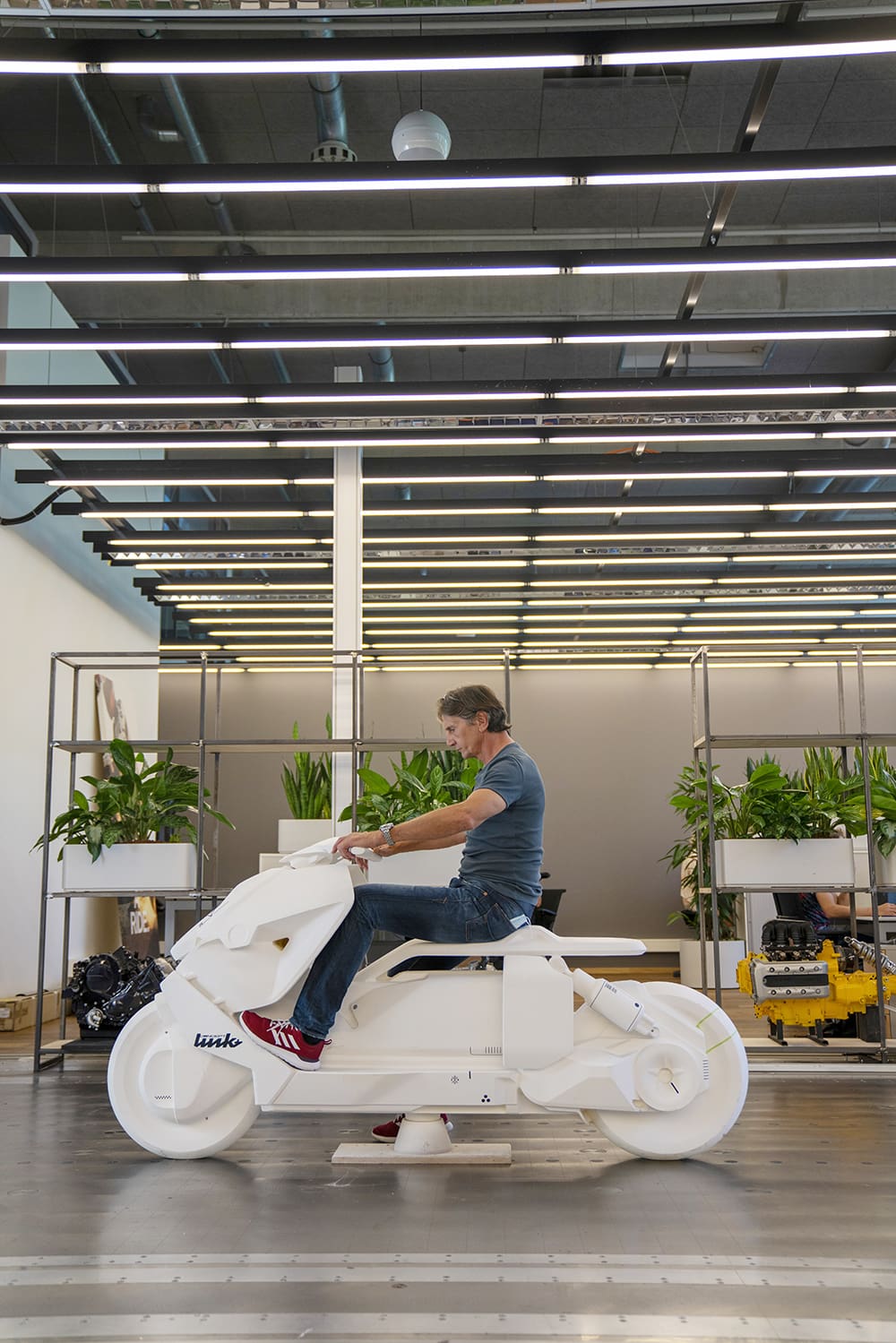
Both the CE 04’s motor and battery are manufactured by BMW itself in Berlin, and like the battery, the chassis-mounted motor is derived from one used in BMW’s hybrid cars. Producing 31kW (42hp) at 4900rpm, it has a purpose-built housing for its scooter application, and drives the rear wheel via a set of single-stage primary gears, leading to a belt final drive. Maximum torque of 62Nm is quoted as delivered at 1500rpm rather than at 1rpm as on most other EVs, denoting that BMW must have softened the initial delivery from a closed throttle for a smoother takeoff. Nonetheless, BMW’s quoted 0-50km/h time of just 2.6secs will win most traffic light GPs, with top speed limited to 120km/h. The CE 04 is LAMS approved.
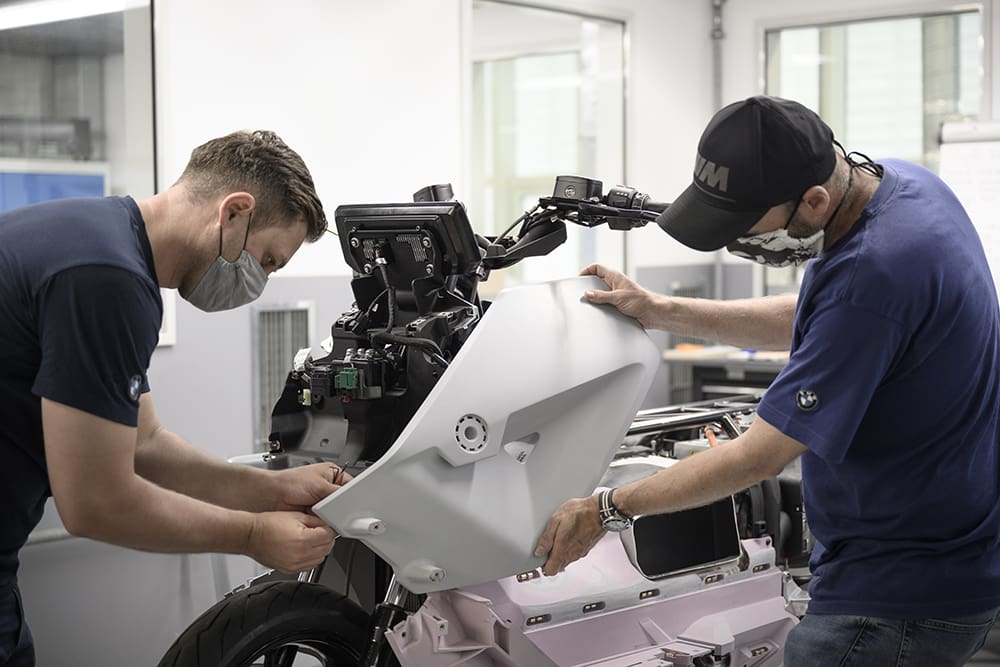
The CE 04’s quoted range of 130km obviously varies according to how hard you work the throttle, though ‘regen’ is available when off the throttle and/or under braking. The air-cooled European-made electronic inverter/controller is mounted directly above the electric motor, which it takes care of controlling within a range of 100-150 volts, while also feeding in rider commands like throttle position, etc, and controlling regen.
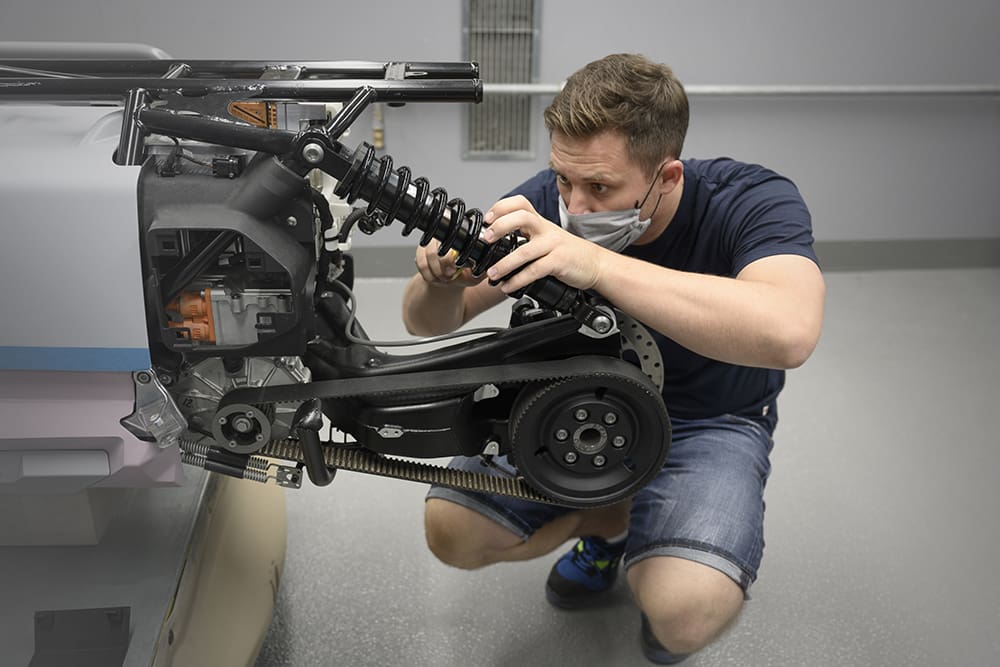
The 147.6-volt battery is charged via the integrated charging device, either via a Level 1 household socket, a Level 2 Wallbox or a Level 2 public charging station. The charging socket is located underneath a cover in the front right-hand leg area, while a storage compartment on the right-hand side houses the standard charging cable. If the CE 04 is equipped with the optional Level 2 cable, charging times are significantly reduced. These vary from 4 hours 20 minutes for 0-100 per cent charge with the Level 1 (2.3kW) charging cable supplied, to 1 hour 40 minutes with the optional Level 2 charging cable (6.9 kW), with 20-80 per cent taking just 45 minutes with the Level 2 cable.
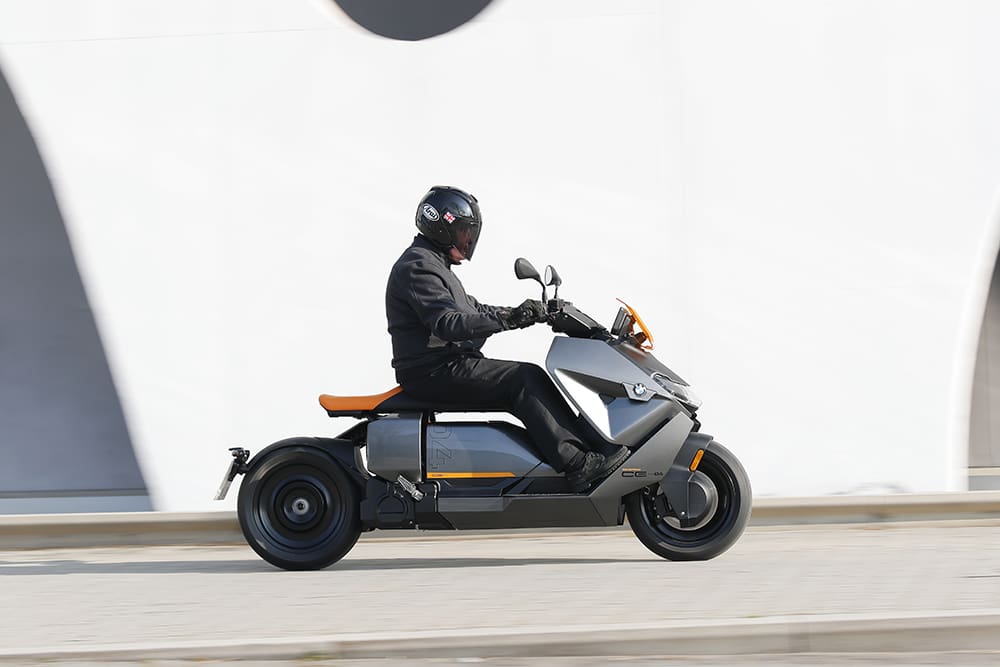
Unlike conventional scooters which have a hinged seat allowing access to under-seat storage, the CE 04’s seat is fixed. But there’s still enough storage beneath it for a full-face helmet, which is neatly accessed from the side, even when you’re seated. But if you dismount to do this, you can’t help but notice that there’s clean air between the top of the storage locker and the seat – a nice styling touch. There’s an additional sealed storage compartment upfront for your phone, which is cooled by an electric fan to prevent it overheating while charging via the socket on the right side.
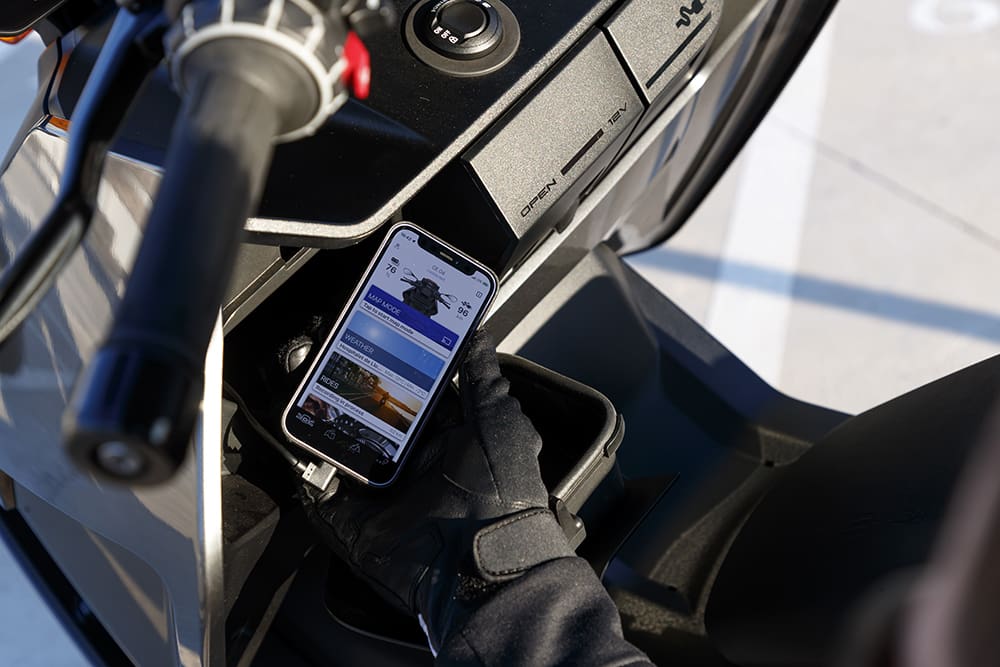
Both storage compartments and the ignition are all keyless, and lock automatically as you leave the bike. The huge 10.25-inch full-colour TFT screen displaying normal bike functions has connectivity, as well as integrated map navigation, and there’s a split-screen facility if you wish. The windscreen in front of the dash gives you minimal protection, but a high screen is an available option, along with a heated seat (one of six different seat options), heated grips and cornering lights.
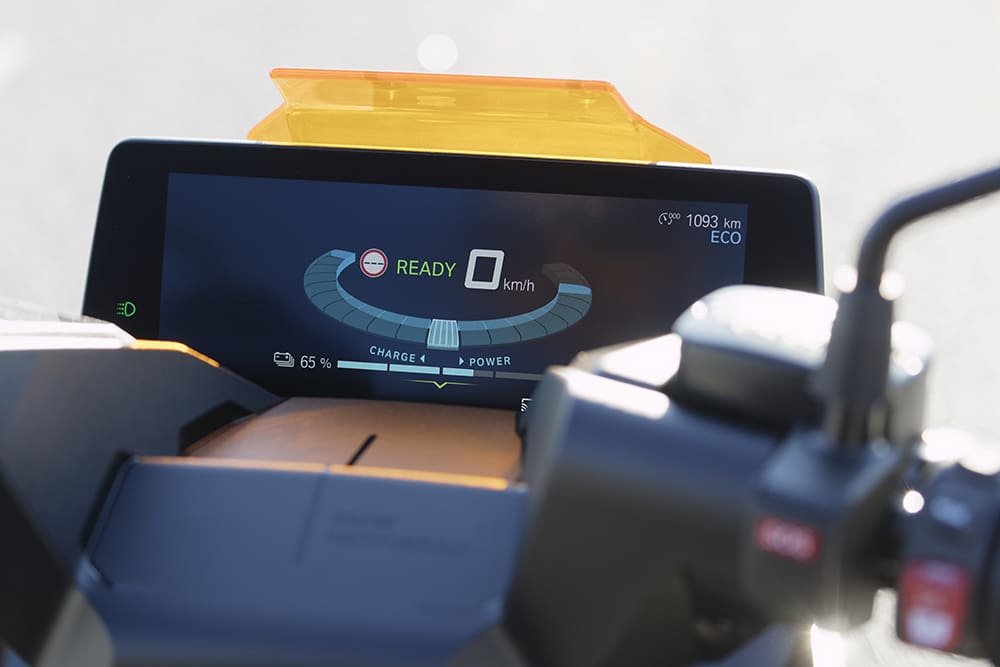
Though there’s marginally better step-though than on its predecessor, the lower, flatter seat makes it easier to simply throw a leg over it, motorbike-style. The 780mm-high seat is fractionally taller than BMW’s own C 400 X scooter at 775mm, but its narrowness makes the CE 04 very accessible, and a reverse gear is fitted as standard.
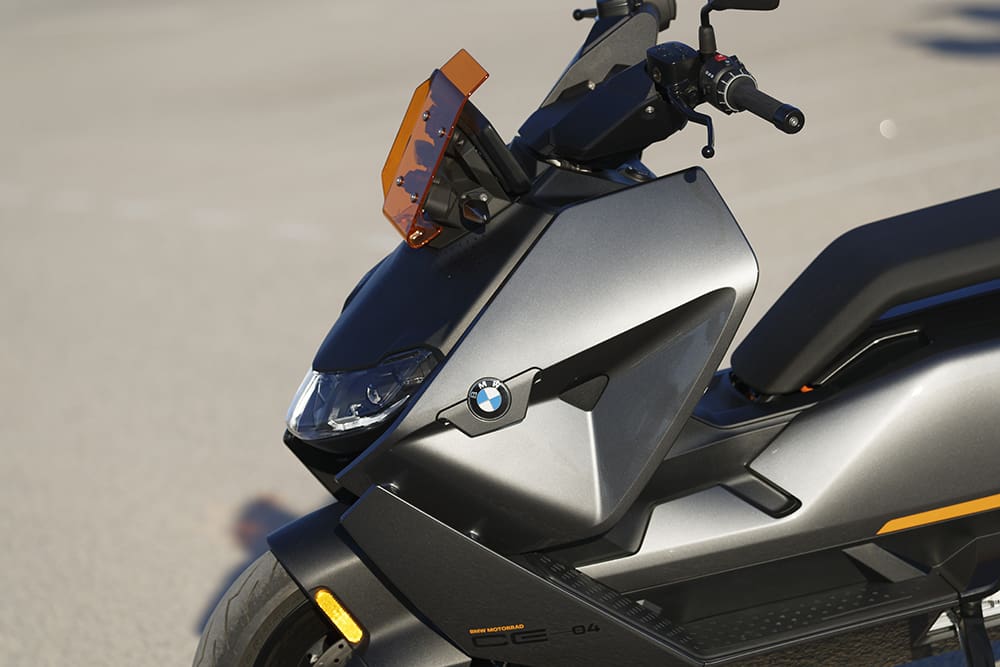
There’s a sense of familiarity to the riding stance for anyone who’s ridden a BMW before. The switchgear, controls and dash are all stock BMW kit, making it easy to get set up with one of the four different rider modes and, most importantly for a 6°C winter morning, crank up the three-stage heated grips. There’s even a normal BMW starter switch on the right, but instead of the usual whirring when you push it, a message simply flicks up on the TFT dash reading ‘Ready’. Check the road behind you, twist the throttle and hang on tight as you catapult forward – the CE 04 is super-responsive, depending which riding mode you’ve selected. It’s so easy to build momentum that you must keep an eye open for Barcelona’s notorious speed cameras. Besides, using the CE 04’s rapid acceleration away from the mark and its effortless pace through town will dramatically reduce BMW’s claimed 130km range. That said, after 68km of sporty riding in every kind of circumstance, from carving corners in city streets, climbing to Tibidabo, a couple of 110km/h squirts on urban freeways, and a lap of the old Spanish GP public roads race circuit in Montjuic, I still had 48km of charge remaining according to the ultra-legible dash countdown – a good part of that doubtless thanks to the regen function.
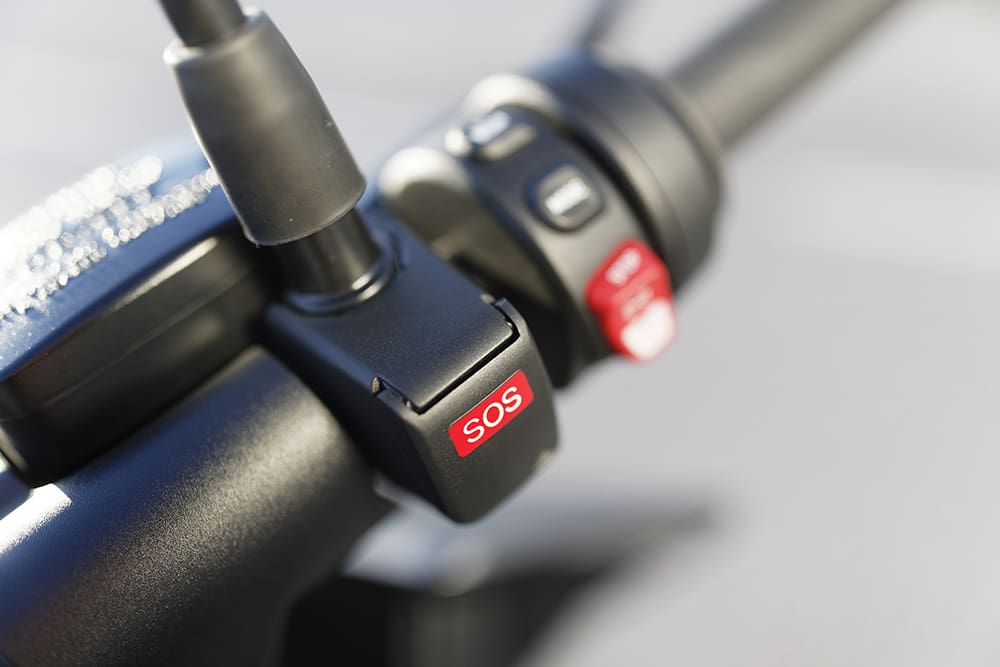
There are three separate standard riding modes – ECO, Road and Rain – with an optional fourth, Dynamic. The Dynamic package adds adaptive headlights, while the traction control and ABS systems become lean-angle sensitive. Each mode has a different throttle response and regen strategy, and each of the three has its uses, though you’ll end up using Road the most, combining maximum acceleration, around 50 per cent regen while off throttle, and full regeneration when braking. This makes it the preferred option when climbing a twisty mountain road, where with reduced engine braking it was much easier to get the CE 04 flowing effortlessly through successive turns, with just a touch of front brake to adjust turn speed to suit.

In Road mode the CE 04 flows effortlessly through traffic, and being narrower than a conventional scooter – especially at the rear where there’s no bulky exhaust or motor acting as the swingarm – it’s easy to lane-split through rush hour traffic in perfect silence. And best of all, you’re always in the right gear, and always ready to exploit the instant pickup to gain territory on the battle of the streets, leaving cars and other two-wheelers for dust.

By contrast, in ECO mode, acceleration and thus energy consumption are restricted, there’s maximum regen while off throttle, resulting in the kind of engine braking you get from a high-compression engine. This makes it hard to go with the flow, resulting in a more stop/start rhythm that’s best for use in traffic, where with such intrusive regen, you often don’t need to use the brakes at all. Crack the twistgrip wide open, and after a sluggish initial pickup, response eventually becomes quite strong – paradoxically, think of it as riding a peaky four-stroke motor tuned for top-end performance.

Rain mode is a little strange, though, because while throttle response and acceleration is much softer, it also sees a reduction in regen while coasting, especially downhill when you’d really like to have extra engine braking on a slippery surface to obviate the need to use the brakes too hard, and risk getting the ABS kicking in. Finally, the optional Dynamic mode is the most aggressive, combining hard acceleration with maximum regen that’s the equivalent of strong engine braking on an ICE bike. That makes it more suited to point and squirt riding, so ideal for descending a twisty hillside road, or carving corners on level ground, but not so good for climbing a twisty hillside road, because the regen cuts in when you back off the throttle to coast through a bend.

The more aggressive throttle curve in Dynamic will make you glad that BMW has installed traction control as standard on the CE 04, which works in a similar way to the BMW’s Automatic Stability Control. The ECU monitors rear-wheel speed, and ASC limits the motor’s torque if a certain plausibility threshold is exceeded, meaning it’s pre-emptive rather than reactive, triggered by an incipient loss of grip at the rear. ASC also intervenes to stop the rear wheel from skidding when intensive regen braking occurs.
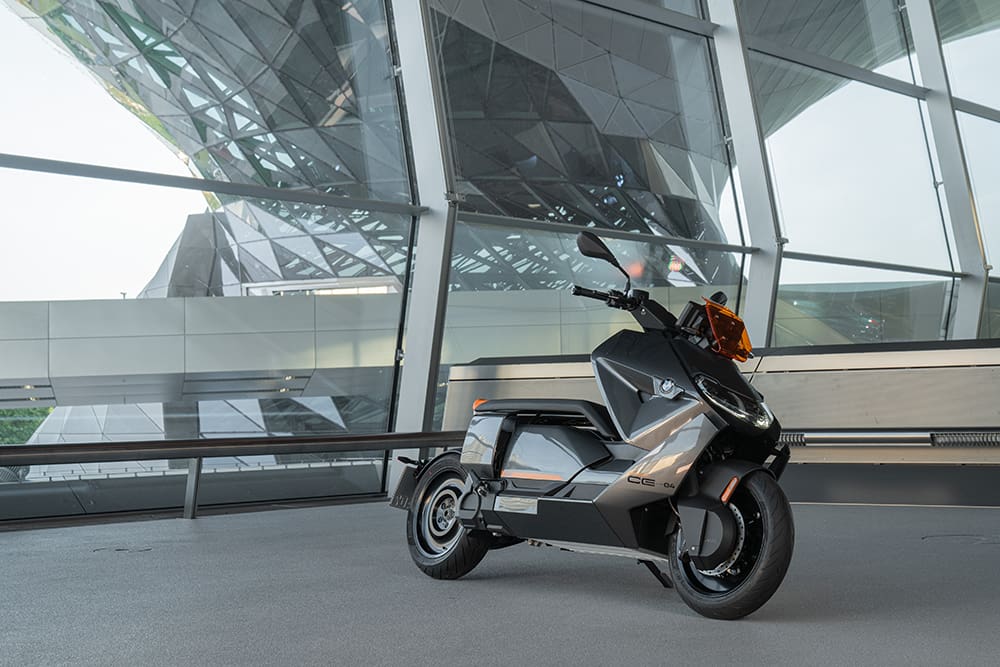
With the 35mm Showa fork offering 110mm of wheel travel set at a 26.5° rake with 120mm of trail, the CE 04 has steering geometry that’s quite similar to a bike’s, just with a much longer 1675mm wheelbase. At the rear, there’s a single-sided swingarm operating a non-adjustable direct-action cantilever Showa shock which, despite its minimal 92mm of travel, gave remarkably good damping and a super-compliant response, to the point that you don’t feel the need to avoid bumps. The long-wheelbase BMW just shrugged them off, its low-down weight also a factor in its stability, with the only payback the need to tug the ’bars a little to keep it on line on a constant radius bend, thanks to its long stride.
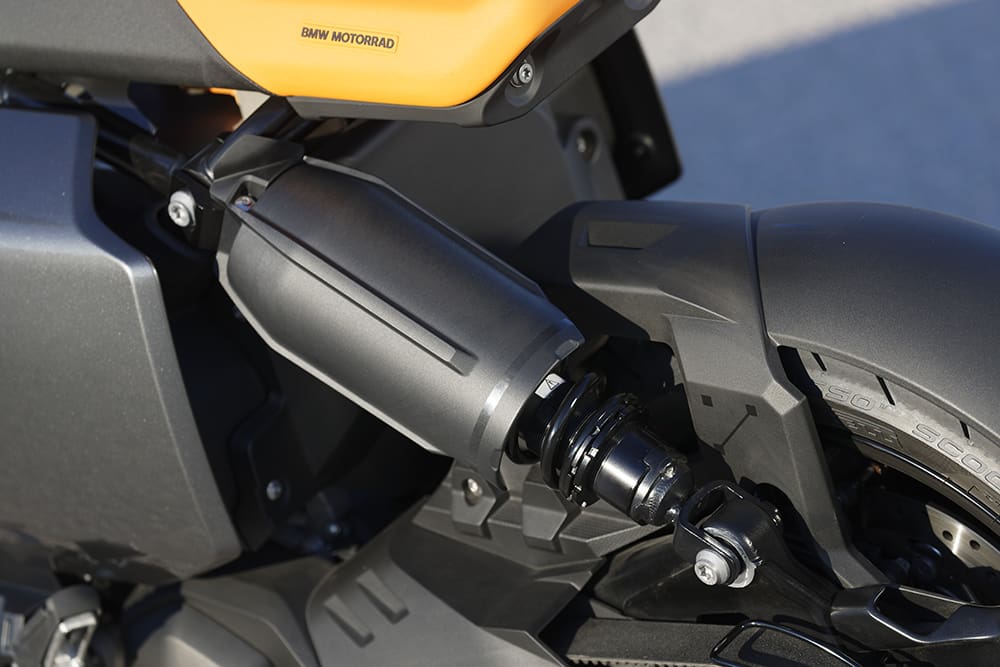
The Pirelli Rosso Scooter tyres gave great grip wile leant over and warmed up really quickly on that cold winter morning – a key factor for a ride-to-work vehicle. Braking is well taken care of by twin 265mm discs up front gripped by fixed four-piston calipers, with a third such disc at the rear with a single-piston caliper, all operated via steel hoses. The standard parking brake is activated automatically whenever you fold out the easily accessible sidestand.
The Bosch 9.3 two-channel ABS allows independent regulation of the two brake circuits for the front and rear brakes. But regen is the king, and depending what mode you’re in, it provides ample assistance to the braking hardware.
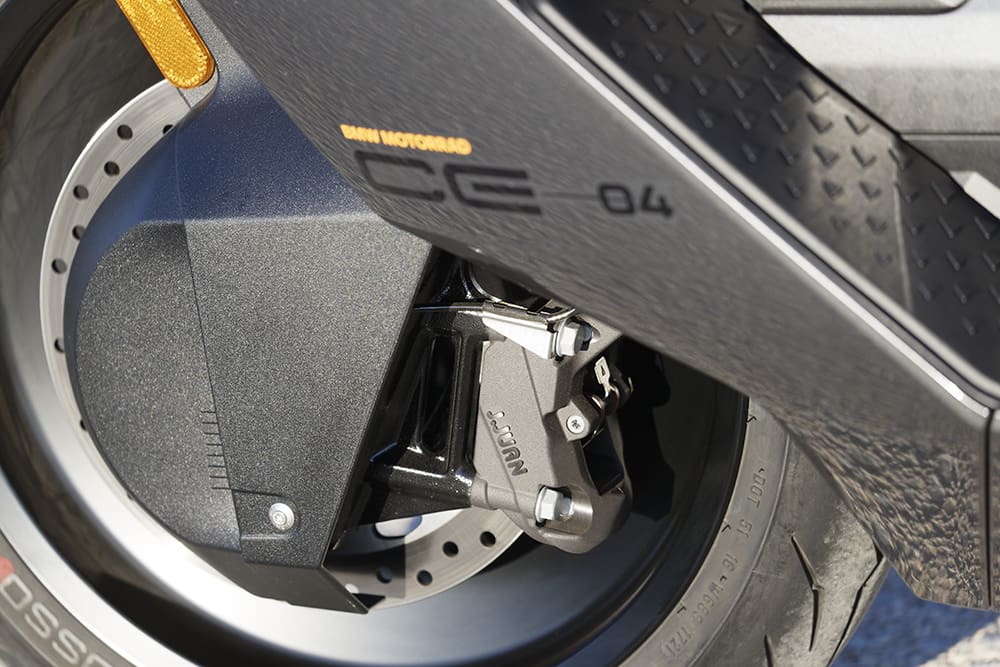
The CE 04 is a fantastic city bike, with its completely mould-breaking design matched by alluring all-round performance, including thrilling acceleration. Its slimness will make it an ideal commuter and, let’s face it, you’ll get noticed wherever you ride it. Well, unless the sound of silence is too discreet. The price is high – but that’s an upfront cost, with only the price of replacement brake pads and possibly a new rear tyre to be added to the bill further down the line.
The CE 04 sets the bar pretty high for those that aim to follow in its tyre tracks, as other manufacturers surely will, with Yamaha perhaps BMW’s most likely major rival to do so. An electric version of the best-selling TMAX combustion scooter going head to head with this new BMW E-scooter? Now there’s a thought!

ONE-ON-ONE
Edgar Heinrich
Edgar, 62, is BMW Motorrad’s
Head of Design
Visually speaking this is a scooter not like any other. How did it come about?
If you look at today’s motorcycles, everything is narrowed down to basically four engine concepts and two frame concepts – everything is very, very limited. With these electric animals which are a whole new species, suddenly you have a white page of paper in front of you. This is why, personally, I don’t agree that ‘electric bikes are boring, it’s just a battery pack and a washing machine motor’. On the contrary, it’s a super interesting brave new world in terms of design, because everything is open. But I must say that we had no idea it would look as good as this!
Very satisfying for your design team, though?
Yes, but look, the world of scooters is very different from motorcycles, because it’s defined by comfort and weather protection, but also by utility. And utility also defines the proportion of the bike, so convention says you have to have small wheels, a big bottom overhang, big fairing, and a comfortable seat – all these things which are not sexy, because utility is not sexy. This is why big scooters have these aggressive lines, but clumsy proportions. And this is what we did not want to do in creating this electric scooter – we said very clearly, this is not our approach.
How did the long bench seat come about?
On standard scooters apparently it’s cooler to have those fat sofas as a normal feature. But we questioned everything. And looking at urban commuting, six-12 minutes is the average scooter journey, so why would I need 200mm of sofa on a scooter?! So a long bench like on the CE 04 offers a lot of other opportunities; you can slide back and forth on it if you feel cramped, you can relax your feet, you can sit forward and more upright – you decide.

Test Alan Cathcart Photography Markus Jahn & Jörg Künstle